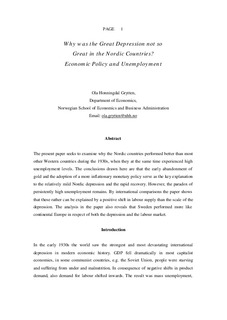| dc.contributor.author | Grytten, Ola Honningdal | |
| dc.date.accessioned | 2006-09-22T06:52:33Z | |
| dc.date.available | 2006-09-22T06:52:33Z | |
| dc.date.issued | 2006-08 | |
| dc.identifier.issn | 0804-6824 | |
| dc.identifier.uri | http://hdl.handle.net/11250/163304 | |
| dc.description.abstract | The present paper seeks to examine why the Nordic countries performed better than most
other Western countries during the 1930s, when they at the same time experienced high
unemployment levels. The conclusions drawn here are that the early abandonment of
gold and the adoption of a more inflationary monetary policy serve as the key explanation
to the relatively mild Nordic depression and the rapid recovery. However, the paradox of
persistently high unemployment remains. By international comparisons the paper shows
that these rather can be explained by a positive shift in labour supply than the scale of the
depression. The analysis in the paper also reveals that Sweden performed more like continental Europe in respect of both the depression and the labour market. | en |
| dc.format.extent | 99889 bytes | |
| dc.format.mimetype | application/pdf | |
| dc.language.iso | eng | en |
| dc.publisher | Norwegian School of Economics and Business Administration. Department of Economics | en |
| dc.relation.ispartofseries | Discussion paper | en |
| dc.relation.ispartofseries | 2006:24 | en |
| dc.title | Why was the Great Depression not so great in the Nordic countries? : economic policy and unemployment | en |
| dc.type | Working paper | en |
